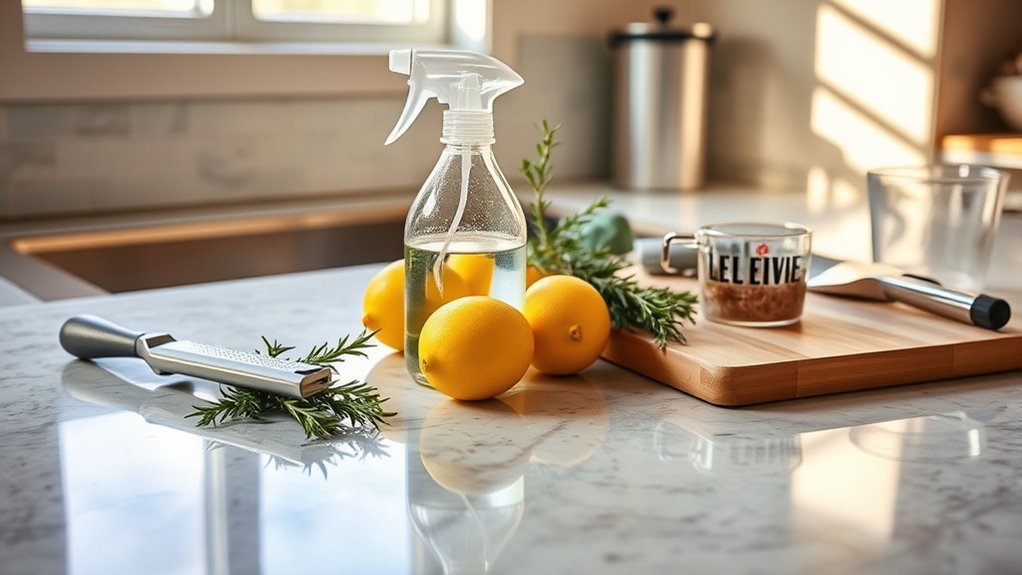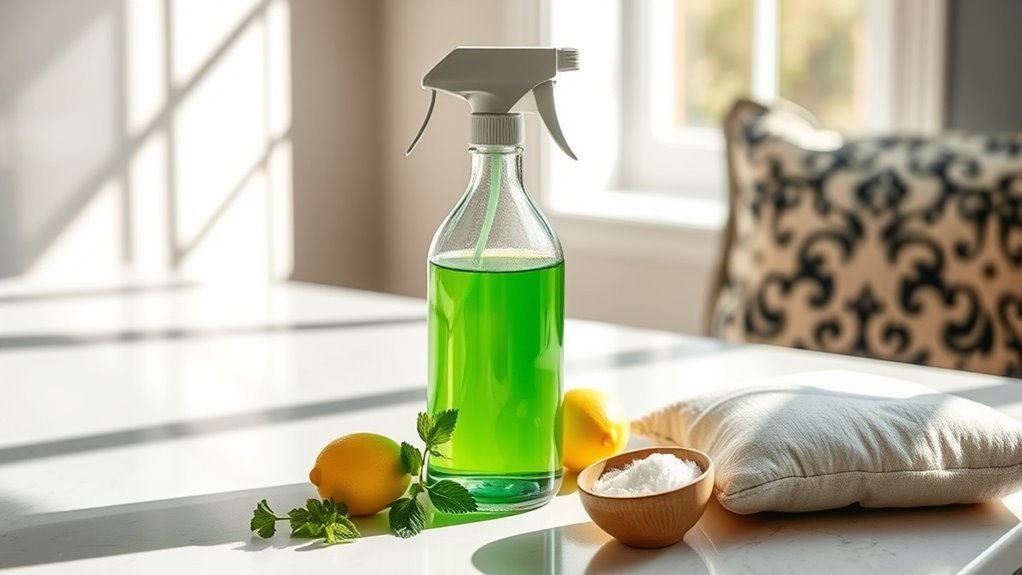How to Make Homemade Living Room Cleaner
You can easily make a safe, effective living room cleaner with simple household items. Mix equal parts distilled water and white vinegar in a spray bottle, and add 10-15 drops of your favorite essential oil for a fresh scent. For wood surfaces, blend water, vinegar, and a bit of olive oil to protect finishes. Use baking soda to deodorize carpets by sprinkling, letting sit, then vacuuming. Keep your cleaner well-labeled and stored safely. There are also handy eco-friendly tools and scent ideas to contemplate next.
Benefits of Using Homemade Living Room Cleaners

One of the key benefits of using homemade living room cleaners is the control you have over the ingredients. You can avoid harsh chemicals and toxins commonly found in commercial products, which means improved health benefits for you and your family, especially if anyone has allergies or sensitivities. This control lets you tailor mixtures to your specific needs, ensuring safer cleaning without compromising effectiveness. Additionally, making your own cleaners offers significant cost savings. Instead of buying expensive, branded products, you use simple, affordable items you likely already have at home. This approach not only frees you from dependency on commercial cleaners but also reduces waste and packaging. By choosing homemade solutions, you gain practical freedom, health advantages, and financial relief in your everyday cleaning routine.
Essential Ingredients for Natural Cleaners
To make an effective homemade living room cleaner, you’ll need a few key natural ingredients like vinegar, baking soda, and castile soap for their cleaning and deodorizing properties. Adding essential oils not only boosts the scent but also provides antibacterial and antifungal benefits. Understanding these components helps you create a cleaner that’s both safe and efficient.
Key Natural Ingredients
Start by gathering a few essential natural ingredients that form the foundation of effective homemade living room cleaners. Vinegar, baking soda, and castile soap are your go-to natural alternatives. Vinegar’s acidity cuts through grime and disinfects surfaces without harsh chemicals. Baking soda acts as a gentle abrasive and deodorizer, boosting cleaning effectiveness on upholstery and carpets. Castile soap provides a mild yet thorough cleansing action, perfect for delicate surfaces. Distilled water serves as a pure base, preventing residue buildup. These ingredients give you control over what goes into your cleaner, ensuring it’s safe and effective. By combining them thoughtfully, you harness their individual strengths, creating a versatile, powerful cleaner that respects your living space and your freedom from toxic substances.
Benefits of Essential Oils
Essential oils bring a powerful boost to your homemade living room cleaner by adding both cleaning properties and pleasant aromas. When you choose essential oils, you’re not just revitalizing the space; you’re harnessing natural fragrances that elevate your environment. Oils like lemon, tea tree, or eucalyptus offer antimicrobial effects, helping to disinfect surfaces without harsh chemicals. Plus, their aromatherapy benefits can reduce stress and improve your mood, creating a more inviting atmosphere. To maximize effectiveness, add 15-20 drops of your chosen essential oil to your cleaner mix, ensuring even distribution. This method keeps your living room spotless and invigorates your senses, giving you a natural, chemical-free way to enjoy a clean and rejuvenating space every day.
How to Make an All-Purpose Spray Cleaner

Although making your own all-purpose spray cleaner might seem complicated at first, it’s actually a straightforward process that requires just a few common ingredients. To create your homemade cleaner, gather:
- 1 cup distilled water
- 1 cup white vinegar
- 10-15 drops of essential oil (like lemon or lavender)
- A clean spray bottle
Start by pouring the distilled water and white vinegar into the spray bottle. Add the essential oil for a rejuvenating scent and added cleaning power. Shake gently to combine. This solution cleans surfaces effectively without harsh chemicals, giving you freedom from commercial product restrictions. Keep your spray bottle handy to tackle dust, grime, and spills quickly. With this simple recipe, you’re empowered to maintain a fresh, clean living room using safe, natural ingredients.
Recipe for a Gentle Wood Surface Cleaner
While the all-purpose spray cleaner works well on many surfaces, wood requires a gentler touch to preserve its finish and natural beauty. To make an effective wood cleaner that guarantees surface safety, mix 1 cup of warm water with 1/4 cup of white vinegar and 1 tablespoon of olive oil. The vinegar gently disinfects without stripping the wood, while olive oil nourishes and adds shine. Use a soft cloth dipped in the solution, wrung out thoroughly, to wipe down your wood surfaces. Avoid saturating the wood to prevent damage. Always test a small, hidden area first to confirm compatibility. This methodical approach lets you maintain your wood’s elegance while enjoying the freedom of a homemade, safe cleaner tailored specifically for wood surfaces.
Creating a Fabric and Upholstery Refresher

If you want to keep your fabric and upholstery smelling fresh and looking clean without harsh chemicals, making your own refresher is a straightforward process. This approach supports fabric freshness and upholstery maintenance while giving you control over ingredients. Here’s how to create your refresher:
- Combine 1 cup of distilled water with 1/4 cup of rubbing alcohol in a spray bottle.
- Add 10 drops of lavender or eucalyptus essential oil for a natural, pleasant scent.
- Shake the bottle gently to mix ingredients evenly.
- Lightly mist your fabric or upholstery surface, allowing it to air dry completely before use.
This method refreshes fabrics, controls odors, and supports regular upkeep, letting you maintain a clean living space with freedom from commercial chemicals.
Vinegar-Based Solution for Glass and Mirrors
Keeping your fabric and upholstery fresh is just one part of maintaining a spotless living room. For glass cleaning, a vinegar-based solution offers remarkable vinegar benefits, cutting through grime and leaving surfaces streak-free. Here’s how you can prepare and apply it efficiently:
| Ingredient | Quantity |
|---|---|
| White vinegar | 1 cup |
| Water | 1 cup |
| Optional: Essential oil | 5 drops (for scent) |
Mix vinegar and water in a spray bottle. Add essential oils if you want a pleasant aroma. Spray on glass or mirrors, then wipe with a microfiber cloth in circular motions. This method harnesses vinegar benefits for a natural, effective clean, freeing you from harsh chemicals and expensive commercial cleaners.
Using Baking Soda for Deodorizing Carpets
A simple yet powerful ingredient for rejuvenating your carpets is baking soda. It’s fantastic for carpet freshening and odor elimination without harsh chemicals. Here’s how you can use it effectively:
- Sprinkle a generous amount of baking soda evenly over your carpet’s surface.
- Gently work it into the fibers with a soft brush to reach deeper odors.
- Let it sit for at least 30 minutes, or overnight for stronger odor elimination.
- Vacuum thoroughly to remove the baking soda along with absorbed smells.
This method frees your living room from unwanted scents while keeping your carpet fresh and inviting. Baking soda’s natural deodorizing power lets you maintain a clean, healthy space effortlessly, giving you the freedom to enjoy your home fully.
Tips for Storing Homemade Cleaners Safely
When you make your own living room cleaner, storing it properly is essential to maintain its effectiveness and guarantee safety. First, always use airtight cleaner containers made from durable materials like glass or BPA-free plastic to prevent leaks and contamination. Avoid repurposing old food jars, as residues can interact with your cleaner. Next, label each container clearly with storage labels that include the cleaner’s name, ingredients, and date made. This helps you track freshness and avoid accidental misuse. Store your homemade cleaner in a cool, dark place away from direct sunlight and heat sources to preserve its potency. Keep it out of reach of children and pets by placing it in high cabinets or locked cupboards. These steps ascertain your cleaner stays safe and effective for your living room freedom.
Eco-Friendly Tools to Use With Your Cleaners
Sustainability goes beyond just the ingredients in your homemade living room cleaner; the tools you use can make a significant environmental impact too. To truly embrace eco friendly materials and sustainable practices, consider these essentials:
- Reusable microfiber cloths – They’re durable, washable, and highly effective at trapping dust without chemicals.
- Bamboo scrub brushes – Bamboo grows quickly and naturally resists bacteria, making it a smart, sustainable choice.
- Glass spray bottles – Unlike plastic, glass is infinitely reusable and won’t leach harmful substances.
- Natural sponges – Opt for biodegradable, plant-based sponges over synthetic ones to reduce landfill waste.
How to Customize Scents With Essential Oils
Choosing the right tools for your homemade cleaner is just one part of creating a pleasant living space; customizing the scent is what truly personalizes it. Start by selecting essential oil blends that resonate with your mood and lifestyle—citrus oils like lemon or orange bring energy, while lavender or chamomile calm the atmosphere. Experiment with scent combinations in small batches, mixing 3-5 drops of each oil per cup of cleaner to find your preferred balance. Keep a record of your favorite blends for easy replication. Remember, less is more with essential oils, so avoid overpowering aromas. By methodically adjusting your essential oil blends, you gain full freedom to create a cleaner that not only refreshes your living room but also reflects your unique scent preferences.
Frequently Asked Questions
Are Homemade Cleaners Safe for Pets and Children?
You’ll want to choose pet safe ingredients and child friendly formulas to guarantee homemade cleaners don’t pose risks. Using natural components like vinegar, baking soda, and essential oils (in safe amounts) helps keep your living space safe for everyone. Always test small areas first and store cleaners out of reach. By being methodical and cautious, you can confidently create effective, non-toxic solutions that protect your loved ones while giving you freedom from harsh chemicals.
How Long Do Homemade Cleaners Last Before Expiring?
Oh sure, your homemade cleaner’s shelf life isn’t exactly forever—unless you’re into science experiments growing in your cabinet. Typically, it lasts about a week to a month, depending on ingredients. To keep it fresh, store it in a cool, dark place, tightly sealed. Label your concoction with the date, so you don’t lose track. This way, you maintain freedom from chemicals without sacrificing effectiveness or safety.
Can Homemade Cleaners Remove Tough Stains Like Ink or Wine?
You can tackle tough stains like ink or wine with homemade cleaners, but their effectiveness varies. For ink stain removal, try a mixture of rubbing alcohol and water applied gently with a cloth—test first to avoid damage. Wine stain removal often involves blotting immediately, then using a paste of baking soda and water to lift the stain. While homemade solutions offer freedom and control, they might not always match commercial stain removers’ strength.
What Should I Do if a Homemade Cleaner Causes Skin Irritation?
If a homemade cleaner causes skin irritation, stop using it immediately. Rinse the affected area with cool water and mild soap to remove any residue. Apply soothing skin irritation remedies like aloe vera or a gentle moisturizer to reduce redness and discomfort. Before using any homemade cleaner again, always perform a skin test on a small patch to check for reactions. This method helps protect your skin while you enjoy your cleaning freedom safely.
Can I Use Homemade Cleaners in a Steam Mop?
You’ll want to check your steam mop’s manual first to confirm steam mop compatibility with homemade cleaners. Many steam mops recommend using just water to avoid damaging internal parts or reducing cleaner effectiveness. If you do use a homemade solution, keep it very diluted and test a small area. This way, you maintain freedom in cleaning choices without risking your mop’s performance or lifespan. Always prioritize safety and device care.






